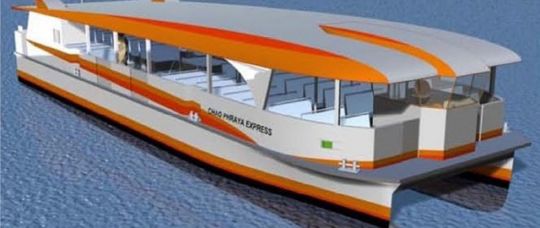A team of Webbies have taken second place in the Worldwide Ferry Safety Association (WFSA) 2017 Ferry Design Competition. The student team, advised by Dean Matthew Werner, consisted of Captain Andrew Vogeler ’18, Brandon Louis ’18, and Nicholas De Sherbinin ’18.
Students from nine institutions, including Webb, submitted designs for a 200 passenger ferry for 30 kilometers of the Chao Phraya River in Bangkok Thailand, with the mandate of providing plans for a vessel that is safe, affordable to construct and operate and is appropriate for its intended geographic place. The University of Liege took first place, Webb second, and the Indian Institute of Technology Kharagpur third.
The team will give a presentation on their vessel at the Ferry Safety and Technology Conference on Thursday, May 11, 2017, in New York City where they will also be receiving their award.
About Webb’s Ferry Design:
The team paid particular attention to ensuring passenger safety and operational efficiency in their design. This was shown through the incorporation of redundancy as a core characteristic in various mechanical systems on board the vessel.
This redundancy is achieved by designing the mechanical systems to be operated by one of two machinery spaces in the ship’s demi-hulls. These systems include the fuel oil system, the carbon dioxide fire suppression system, the fire main system, electrical power system and the steering gear control.
The team also designed easy open/removable windows to provide an easy escape from the vessel in the event of a major emergency.
In order to keep the vessel affordable, the hull is comprised of uniplanar curves aimed at reducing manufacturing costs, while still maintaining efficiency and pleasing aesthetics. The team also planned to reduce the overall maintenance cost of vessel through the use of local shipyards and mechanics, as well as through the use of Cummins engines and generators. The ferry also makes use of a simple interior design, which allows for reduced manufacturing costs when compared to other catamaran ferries.
The team also considered ease of operation by designing a midship loading station which would allow the vessel to be docked at the existing piers. The transverse offset of the propellers relative to centerline increases maneuverability of vessel at low speed operation, while a raised pilothouse and strategic bench placement increases overall pilot visibility. The use of a CCTV system was considered to provide the pilothouse with exterior views of vessel during operation.

